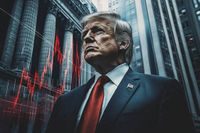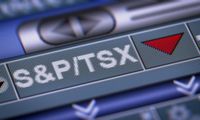Markets were thrown into disarray on Wednesday, April 2, 2025, following President Trump’s surprise escalation of trade tariffs, which exceeded even the most pessimistic investor expectations. What was anticipated as a simple 10% flat tariff across imports morphed into a complex matrix of punitive, country-specific rates—triggering a rapid sell-off in global equities and reigniting safe-haven demand.
Initially, investors responded with mild optimism, but sentiment quickly collapsed as Commerce Secretary Howard Lutnick unveiled specific tariff rates: 34% on Chinese goods, 20% on EU imports, 46% on Vietnam, and 32% on Taiwan. The new measures catapulted the average U.S. tariff rate to 22%, a level not seen since the early 20th century, up from just 2.5% last year. Analysts characterized the announcement as “shock and awe,” with Wedbush’s Dan Ives calling it “worse than the worst-case scenario.”
The Dow dropped over 1,000 points in overnight trading, while the S&P 500 fell back into correction territory. The market reaction was swift; gold surged to an all-time high of $3,167.57 per ounce, while Treasury yields sank as investors flocked to safe-haven assets. Currency markets reflected policy confusion: the U.S. dollar initially strengthened but quickly reversed, losing ground to the yen and euro as traders weighed tariff-driven inflation against possible domestic protectionist gains.
The capital rotation into gold and bonds signals investor expectations of prolonged economic disruption. These tariffs complicate the Federal Reserve’s path forward. Previously expected rate cuts to support slowing growth may now be limited by renewed inflation pressure. UBS forecasts 75–100 basis points of cuts for the remainder of 2025 and has revised its U.S. growth outlook to below 1%. The risk of stagflation—stagnant growth combined with rising prices—has become more pronounced, limiting policy flexibility.
The global response remains uncertain but potentially severe. Canadian and Mexican leaders are already coordinating retaliation, while Europe and China weigh their next moves. Retaliatory tariffs could deepen the disruption, particularly for multinationals with exposure to global supply chains. The immediate outlook remains bearish, particularly for companies reliant on imports or international exposure. Sectors such as retail, consumer brands, and tech are likely to face continued pressure.
On Thursday, April 3, futures stats suggested that the Dow Jones was set to open more than 1,000 points (2.4%) lower, with the S&P 500 and Nasdaq futures down around 3%. Retailers who rely on low-cost goods, such as Dollar Tree and Five Below, saw their stocks plummet, with Dollar Tree down 11% and Five Below down 14%. Nike’s stock dropped more than 8%, while Apple and Robinhood fell by 7%.
Bloomberg’s Dollar Spot Index dropped as much as 1% to a five-month low, as global currencies gained; the euro was up 1%, the yen was up 1%, and the pound was up 0.8%. Gold hit a new high, and U.S. 10-year Treasury yields dropped to a five-month low towards the 4% mark.
“There’s clearly a tolerance for pain on the part of the administration in pursuit of trade goals that are not necessarily entirely economic in nature,” remarked Ross Mayfield, an investment strategist at Baird. “At this point, I’m still in the camp that we’re not on the doorstep of a recession, but maybe a slowdown or growth scare. Non-recession sell-offs tend to be shorter and milder than the recessionary ones.”
The tariffs, which range from a base level of 10% to as high as 50% for what the president termed the “worst offenders” in unfair trade practices with the U.S. over many decades, are in addition to existing tariffs. This means countries like China, already facing a 20% tariff, will now see a new 34% rate imposed.
Despite the turmoil, Wall Street analysts remain cautiously optimistic about Chinese and Hong Kong stocks, citing government support and diverse export markets. Nicholas Chui, a fund manager at Franklin Templeton, noted that China represents the “largest opportunity set for investors.” UBS and JPMorgan also showed optimism for China’s equities.
“Eye-watering tariffs on a country-by-country basis scream 'negotiation tactic,' which will keep markets on edge for the foreseeable future,” said Adam Hetts, Portfolio Manager and Global Head of Multi-Asset at Janus Henderson Investors. “Fortunately, this means there's substantial room for lower tariffs from here, albeit with a 10% baseline in place. We've seen the administration have a surprisingly high tolerance for market pain; now the big question is how much tolerance it has for true economic pain as negotiations unfold.”
Globally, the Nikkei 225 index was down almost 3%, the Hang Seng was down 1.5%, and the Stoxx600 was down 1.5%. The immediate future for the markets appears uncertain as investors grapple with the ramifications of these tariffs and their potential impact on the global economy.





